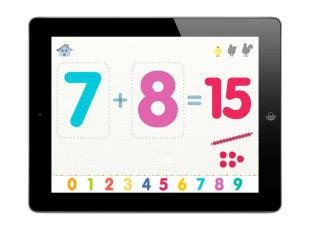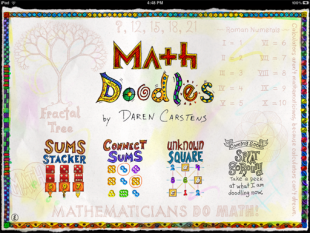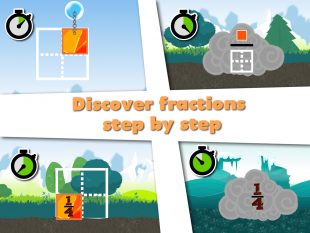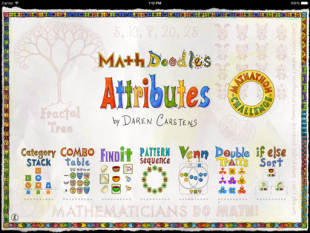2018 School Spending Survey Report
A Mathemagician's Playbook | Apps
Criteria for selecting math apps and a few stellar examples.
 I have loved math for as long as I can remember, in part because my dad made math fun. A mathematician, he would share puzzles or riddles with me that we would solve together. I felt joy in finding a solution along with deep wonder and a sense of mastery when I could pick apart what made a puzzle or problem work. The process yielded a solution that worked in the same way again and again. These games quietly introduced me to mathematical concepts I would not encounter until years later in my classes. (I met my old friend, the Königsberg Bridge Problem, in eighth grade geometry during a unit on graph theory.) By the time teachers and textbooks introduced these ideas and topics, they felt familiar and enjoyable. Not everyone is lucky enough to have a self-proclaimed "mathemagician" in their lives early on, so math is often the stuff of endless workbooks and frustrating confusion. Luckily, there are apps out there to help learners explore concepts, test their understandings, and practice their skills in an entertaining, rewarding manner. What makes a good math app? Like any app, it should be well-designed, thoughtfully created, and appealing to its target audience. The content should also reinforce sound concepts via solid pedagogical practices. Teacher and writer Tracy Zager puts forth these three criteria:
I have loved math for as long as I can remember, in part because my dad made math fun. A mathematician, he would share puzzles or riddles with me that we would solve together. I felt joy in finding a solution along with deep wonder and a sense of mastery when I could pick apart what made a puzzle or problem work. The process yielded a solution that worked in the same way again and again. These games quietly introduced me to mathematical concepts I would not encounter until years later in my classes. (I met my old friend, the Königsberg Bridge Problem, in eighth grade geometry during a unit on graph theory.) By the time teachers and textbooks introduced these ideas and topics, they felt familiar and enjoyable. Not everyone is lucky enough to have a self-proclaimed "mathemagician" in their lives early on, so math is often the stuff of endless workbooks and frustrating confusion. Luckily, there are apps out there to help learners explore concepts, test their understandings, and practice their skills in an entertaining, rewarding manner. What makes a good math app? Like any app, it should be well-designed, thoughtfully created, and appealing to its target audience. The content should also reinforce sound concepts via solid pedagogical practices. Teacher and writer Tracy Zager puts forth these three criteria: - "No time pressure." Time restraints foster math anxiety, which causes decline in performance.
- "Conceptual basis for the operations." Avoid apps with drills and flashcards. Zager states "mathematical models like arrays, groups, hundreds charts, and number lines" should do the illustrating.
- "Mistakes must be handled productively." Apps should help kids learn from incorrect responses, not force them to try again without feedback or deduct points from a score and move them along.

Screen from Fiete Math (Ahoiii)

Screen from More or Less (Marbotic)
More or Less (Marbotic, iOS, $2.99; Android, $2.99; Gr PreK-1) More or Less allows learners who are ready for purely symbolic representations of addition and subtraction to practice with simple single-digit, two-operand equations. A difficulty toggle allows users to switch between choosing two numbers to be added or subtracted, with or without the solution. Another setting requires children to determine the missing operand in a problem, but provides the sum or difference (for example, 4 + ? = 8). Small dots appear below each number. These dots either flow or can be flicked across to the other side of the equation where they will string themselves into a group to help reinforce the connection between a quantity and its numerical symbol. Individual numbers are consistently one particular color, as are the equal number of dots. A set of physical wooden numbers can be purchased separately; when placed on the screen, the tablet recognizes them as input, blending a physical and digital understanding of abstract concepts. The app supports 11 European languages (although the American English sometimes sounds like a digitally-altered British English) and features music that combines simple instrumentals with narration. The narration, pleasing music, and brightly-colored visuals combine to create a simple but charming package.
Screen from Math Doodles (Carstens Studios Inc)
Math Doodles (Carstens Studios Inc., iOS, $2.99; Gr 1-5) In four different minigames, each with two difficulty levels, users practice addition and subtraction. It’s a simple idea, but three of the four games have an additional dimension: values can be expressed not just with familiar Arabic numerals but with dice; hands showing different numbers of fingers; tally marks (including Spanish tally marks); Roman numerals; Chinese, Gurmukhi, Hebrew, Hindi, and Braille numbers; binary notation; English or Spanish words; scientific prefixes; polygons; American coins and bills; area or bar or numerical fractions; or a mix of all of these at once. Similarly, the fourth game, which explores addition via segments of a circle, can be set to use time notation, fractions, percentages, angles, or radians. As a result, this app can be used with younger learners who are still mastering addition and subtraction, or with older learners who are practicing using new symbols or even other languages to express quantities. In an introductory animation, Daren Carstens, the app creator, explains how he found math boring as a kid and mostly doodled in his notebook. As an adult, he sees math as engaging and fun. He still doodles, which establishes the aesthetic for this app. While sometimes busy, but the artwork does set it apart. Audio effects are a little cheesy, but not distracting or repetitive. A webpage offers printables and demos. Overall, an app with surprising breadth.
Slice Fractions (Ululab)
Slice Fractions (Ululab, iOS, $3.99; Android, $5.99; Gr 3-5) Among all the apps mentioned here, this one has the strongest storyline: a young woolly mammoth is trying to go about his day when an angry volcano spews chunks of molten lava across the landscape, leaving it up to players to strategically split and drop blocks of ice onto the lava to clear the way. While at first this may appear to be a gimmick, the app is an introduction to fractions that progressively builds on concepts, as ice blocks must be split to counteract varying sizes of lava chunks. First, those ice blocks are simply split into parts; next, the parts are depicted as portions of a whole (e.g., four small squares making a larger square representing quartering the block); then numerical symbols are superimposed on the chunks of ice; until finally, the chunks are obscured by steam with the numerical symbols still showing. Quantities must be compared and ordered, light puzzle-platforming must be accomplished, and fractions added and subtracted for the woolly mammoth to complete his journey. Choices in app design support learning. Users can jump right in to the appropriate concept-based level without having to complete earlier levels. There is no clock ticking, and levels can be restarted as many times as necessary. While finishing a level yields a new hat for the mammoth, these rewards never feel like the deluge of pointless trinkets found in some games. Errors are handled particularly deftly: if unequal quantities of ice or lava meet, some quantity of one will be left over, giving a clue as to what went wrong. Of the apps examined here, this one has the longest playtime to fully complete. Both fun and instructive: take a peek.
Screen from Attributes
Attributes by Math Doodles (Carstens Studios Inc., iOS, $2.99; Gr 3-8) Similar to Math Doodles, Attributes’s seven hand-drawn minigames provide a relaxed framework in which to explore different concepts. The overarching theme here is patterns. (Explains the creator: “Math is greater than numbers.”) The games require users to notice different qualities objects might have (color, shape, design, and so on) and to move, select, or sort them (into tables or Venn diagrams, for example) accordingly, as multiple difficulty levels become unlocked. The most advanced game serves as an introduction to coding concepts via if-else sorting, and a Mathathon Challenge bundles together 10 rounds of all seven activities. Appsters are likely to feel like they are puzzle-solving rather than problem-solving. Early levels of some games can be completed by elementary school users, but later levels of the same game are complex enough to be challenging and fun for older players. While there are more comprehensive or overtly educational apps (such as Khan Academy) on the market, the selections featured above combine sound underlying concepts with engaging gameplay, solid design, and appealing visuals that learners and players of many ages will enjoy. Gretchen Kolderup (@librarified) is the Youth Librarian at the St. Helens (OR) Public Library. She has a bachelor's degree in math and once thought she wanted to be a math professor before coming to her senses and becoming a librarian instead.For additional app reviews, visit School Library Journal's dedicated app webpage.
RELATED
RECOMMENDED
CAREERS
The job outlook in 2030: Librarians will be in demand
CAREERS
The job outlook in 2030: Librarians will be in demand
ALREADY A SUBSCRIBER? LOG IN
We are currently offering this content for free. Sign up now to activate your personal profile, where you can save articles for future viewing






Add Comment :-
Be the first reader to comment.
Comment Policy:
Comment should not be empty !!!